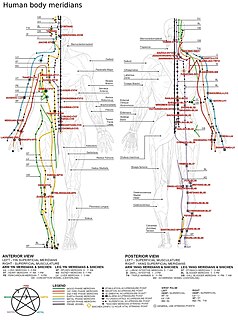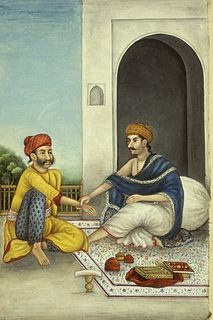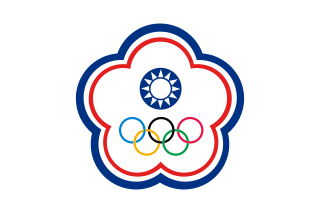
Acupuncture is a form of alternative medicine and a component of traditional Chinese medicine (TCM) in which thin needles are inserted into the body. Acupuncture is a pseudoscience; the theories and practices of TCM are not based on scientific knowledge, and it has been characterized as quackery. There is a range of acupuncture variants which originated in different philosophies, and techniques vary depending on the country in which it is performed, but can be divided into two main foundational philosophical applications and approaches, the first being the modern standardized form called eight principles TCM and the second an older system that is based on the ancient Taoist Wuxing or better known as the five elements or phases in the West. Acupuncture is most often used to attempt pain relief, though acupuncturists say that it can also be used for a wide range of other conditions. Acupuncture is generally used only in combination with other forms of treatment.
Alternative medicine is any practice that aims to achieve the healing effects of medicine, but which lacks biological plausibility and is untested, untestable or proven ineffective. Complementary medicine (CM), complementary and alternative medicine (CAM), integrated medicine or integrative medicine (IM), and holistic medicine are among many rebrandings that describe various ways alternative medicine is combined with mainstream medicine. Alternative therapies share in common that they reside outside of medical science and instead rely on pseudoscience. Traditional practices become "alternative" when used outside their original settings without proper scientific explanation and evidence. Frequently used derogatory terms for the alternative are new-age or pseudo, with little distinction from quackery.

Traditional Chinese Medicine (TCM) is an alternative medical practice drawn from traditional medicine in China. It has been described as "fraught with pseudoscience", and the majority of its treatments as having no logical mechanism of action.

Wuxing, usually translated as Five Phases, is a fivefold conceptual scheme that many traditional Chinese fields used to explain a wide array of phenomena, from cosmic cycles to the interaction between internal organs, and from the succession of political regimes to the properties of medicinal drugs. The "Five Phases" are Fire, Water, Wood, Metal or Gold, and Earth or Soil. This order of presentation is known as the "Days of the Week" sequence. In the order of "mutual generation", they are Wood, Fire, Earth, Metal, and Water. In the order of "mutual overcoming", they are Wood, Earth, Water, Fire, and Metal.
San Jiao is a concept in traditional Chinese medicine (TCM) and acupuncture. It is the sixth organ of Fu, which is the hollow space inside the trunk of our body. In TCM, there are five solid organs and each solid organ has its counterpart in a hollow organ. For instance, the heart is considered a solid organ, and the small intestine its hollow counterpart, or Fu organ. San Jiao is believed to be a body cavity of some kind which has the ability to influence other organs, and overall health, mainly through the free movement of Qi, the fundamental energy or life force.

Traditional Korean medicine refers to the forms of traditional medicine practiced in Korea.

The meridian system is a concept in traditional Chinese medicine (TCM). Meridians are paths through which the life-energy known as "qi" flows.

Rhodiola rosea is a perennial flowering plant in the family Crassulaceae. It grows naturally in wild Arctic regions of Europe, Asia, and North America, and can be propagated as a groundcover.

Pulse diagnosis is a diagnostic technique used in Ayurveda, traditional Chinese medicine, traditional Mongolian medicine, Siddha medicine, traditional Tibetan medicine, and Unani. Although it once showed many positive results, it no longer has scientific legitimacy, but research continues and is ill-defined in some derived text, and is subjective.

Chi-Huey Wong is a Taiwanese-American biochemist. He is currently the Scripps Family Chair Professor at the Scripps Research Institute, California in the Department of Chemistry. He is a member of the United States National Academy of Sciences, won the Wolf Prize in Chemistry and the RSC Robert Robinson Award. and has published more than 700 papers and holds more than 100 patents.
The Shanghan Lun is a part of Shanghan Zabing Lun (simplified Chinese: 伤寒杂病论; traditional Chinese: 傷寒雜病論; pinyin: Shānghán Zábìng Lùn. It is a Traditional Chinese medicine treatise that was compiled by Zhang Zhongjing sometime before 220 AD, at the end of the Han dynasty. It is amongst the oldest complete clinical textbooks in the world. It is considered one of the four canonical works of Traditional Chinese medicine, along with Huang Di Nei Jing, Jin Gui Yao Lue, and Wen Bing Xue.
Blood stasis (BS) is a concept in traditional Chinese medicine (TCM), described as a slowing or pooling of the blood due to a disruption of heart qi. Blood stasis is also described by practitioners of TCM in terms of yin deficiency, qi deficiency and qi stagnation. For non-practitioners of TCM it is sometimes explained in terms of hematological disorders such as hemorrhage, congestion, thrombosis or local ischemia, and in terms of tissue changes. TCM practitioners believe it is an important underlying pathology of many disease processes despite the fact that objective, consistent methods for measuring the presence of blood stasis syndrome are not readily available. Blood stasis is associated with justifications for acupuncture and herbal treatments.
The history of medical diagnosis began in earnest from the days of Imhotep in ancient Egypt and Hippocrates in ancient Greece but is far from perfect despite the enormous bounty of information made available by medical research including the sequencing of the human genome. The practice of diagnosis continues to be dominated by theories set down in the early 20th century.

Eight Thousand Li of Cloud and Moon is a Taiwanese television series based on the life of Yue Fei, a Song dynasty general widely regarded as a patriot and national hero in Chinese culture for his role in the Jurchen campaigns against the Song dynasty. The Chinese title of the series comes from a line in Man Jiang Hong, a patriotic poem commonly attributed to Yue Fei. The series was first aired on CTS in Taiwan from 21 November 1988 to 13 January 1989.
Dennis Yuk Ming Lo is a Hong Kong molecular biologist, and an important contributor to the development of non-invasive prenatal testing. He is the current Associate Dean (Research) and Li Ka Shing Professor of Medicine at the Chinese University of Hong Kong (CUHK), as well as the Head of the Department of Chemical Pathology of CUHK and the Director of the Li Ka Shing Institute of Health Sciences. His research focuses on the detection of cell-free fetal DNA in blood plasma.

Antrodia cinnamomea is a fungus species described as new to science in 1995. It causes brown heart rot of the aromatic tree Cinnamomum kanehirae. It is used in Taiwanese traditional medicine as a supposed remedy for cancer, hypertension, and hangover. The annual market is worth over $100 million (US) in Taiwan alone. The 32.15 Mb genome containing 9,254 genes has been sequenced.

Chinese Taipei competed at the 1994 Asian Games in Hiroshima, Japan. This was their 6th appearance in the Asian Games. They won at total of 7 gold, 13 silver, and 24 bronze medals, or 44 medals in total. They improved from the previous Asian Games in 1990, where they won a total of 31 medals. They won the most medals in Judo, where they got a total of 1 silver and 5 bronze.

Light the Night, previously known as Blue Hour, is a 2021 Taiwanese Netflix original series written by Ryan Tu and directed by Lien Yi-chi. The series stars Ruby Lin, Yo Yang, Cheryl Yang, Rhydian Vaughan, Derek Chang, Puff Kuo, Esther Liu, Cherry Hsieh and Nikki Hsin-ying Hsieh.

Liver angiosarcoma also known as angiosarcoma of the liver or hepatic angiosarcoma is a rare and rapidly fatal cancer arising from endothelial that line the blood vessels of the liver. It is a type of angiosarcoma. Although very rare with around 200 cases diagnosed each year, it is still considered the third most common primary liver cancer, making up around 2% of all primary liver cancers. Liver angiosarcoma can be primary, meaning it arose in the liver, or secondary, meaning the angiosarcoma arose elsewhere and metastasized to the liver. This article covers PHA, however much is also applicable to secondary tumors.













